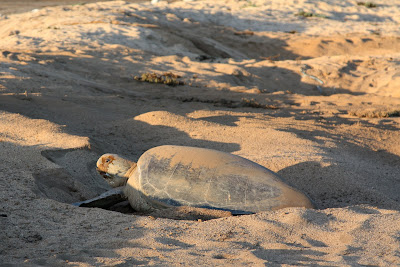
Every three or four years a mature female Atlantic green turtle makes the 2000km journey to Ascension. She swims at a rate of up to 50km a day for 5-6 weeks to get here, a small spec of an island in the middle of the vast ocean that offers her no foraging opportunities. But these massive creatures, which can weigh up to 300kg and measure 1.5m long, store up enough fat to make the long ocean voyage out and back to the coasts of Brazil and West Africa.

Shortly after she arrives at Ascension, a female green turtle is "covered" (what a terrific euphemism) by 4 or 5 different males. These "coverings" can last for several hours and are very splashy affairs. Then she finds a ledge, about 20 meters deep, to wedge herself. For a month she hangs out at that ledge, only surfacing once an hour to breathe.
After a month she is ready to begin laying eggs. At nightfall she swims ashore at the beach where she was hatched, over 25 years ago. As graceful as turtles are in the water, they are equally ungainly on land. It takes her a while to get up the steep beach and high above the tideline. Once she finds a spot she likes, she begins digging, using her front and rear flippers to fling sand out of her way. This is exhausting work for her. She pauses regularly to take a deep breath, the difficulty of her task clearly apparent. In the dark of night, the only sounds on the beach are the sounds of turtles dragging themselves up the beach, flinging sand, and the loud "pshhh" of their breathing.

Then she digs a big hole, up to a meter deep, in which to deposit her eggs. Once she has laid 100 to 120 eggs, she pats the sand down firmly, then begins flinging tons of sand around to disguise her nesting site. Once she has finished, as the sun is rising she ponderously makes her way back to the ocean. As she does, another turtle, which had been digging a nest next to hers, begins to disguise its nest, and in the process dislodges many of the eggs she painstakingly laid and buried. But no matter, in two weeks she'll be back again to lay another clutch of eggs.

As the dawn breaks, the beach is revealed to be a continuous field of craters where turtles have nested and attempted to disguise their nests. Long lines of turtle tracks, like tank tracks, lead to and from the surf. In amongst the deeper tracks, small indents, so shallow they might have been made by raindrops, depict where hatchlings have made a dash to the sea.

Baby turtles dig their way out of their nests in the cool of night. Once clear, they make a mad dash for the water. As the sky lightens, frigatebirds circle overhead, hoping to spot any stragglers. This morning there is one, a tiny little guy scurrying across the sand towards the water as fast as his flippers will carry him.

The birds swoop and dive, but a group of people surrounds him, protecting him until he can reach the water. Once he is in the sea he will face many more predators, but somehow he knows to make for deeper water where there are fewer creatures hunting him. If he survives, in about 25 years he will make the return journey to Ascension to participate in this ancient cycle of life.




1 comment:
Hi there sv MATA'IREA.. Yours is the simplest, most succinct and beautiful snapshot of life-in-the-wild... that I've come across in a long time... bon voyage towards Barbados.... I may see you aboard sv SUMATRA in the Caribbean before she departs for The Med. Cheers from DV in The Whitsundays
Post a Comment